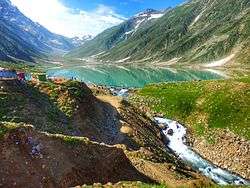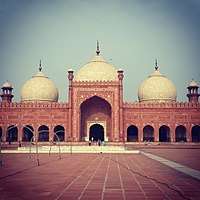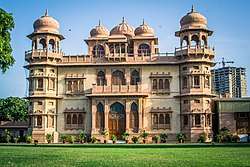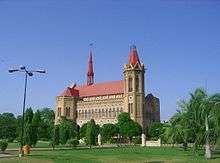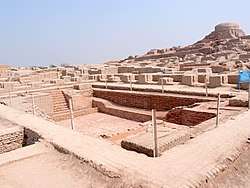Tourism in Pakistan
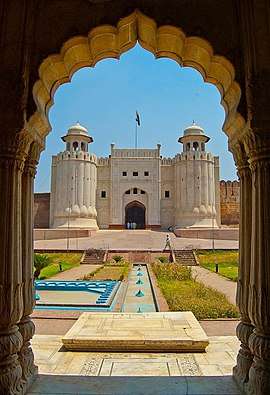
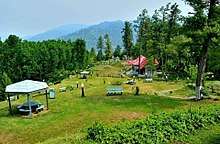
Tourism in Pakistan is a growing industry.[1][2][3] In 2010, Lonely Planet termed Pakistan as being "...tourism's ‘next big thing’ for more years than we care to remember. [But] world media headlines [always] send things off the rails".[4] In 2018, the British Backpacker Society ranked Pakistan as the world's top adventure travel destination, describing the country as "one of the friendliest countries on earth, with mountain scenery that is beyond anyone’s wildest imagination."[5] This geographically and ethnically diverse country has much to offer, from natural beauty and historical heritage to cultural diversity. According to the Travel and Tourism Competitiveness Report 2017 released by the World Economic Forum, the direct contribution of travel and tourism to Pakistan's GDP in 2015 was US$ 328.3 million, constituting 2.8% of the total GDP.[6] According to the World Travel and Tourism Council, the direct contribution of travel and tourism to Pakistan's GDP in 2016 was US$ 7.6 billion (PKR 793.0 billion), constituting 2.7% of the total GDP.[7] By 2025, the government predicts tourism will contribute ₨1 trillion (US$9.5 billion) to the Pakistani economy.[8]
In October 2006, one year after the 2005 Kashmir earthquake, The Guardian released what it described as "the top five tourist sites in Pakistan" to help the country's tourism industry.[9] The sites included Lahore, the Karakoram Highway, Karimabad and Lake Saiful Muluk. To promote the country's unique cultural heritage, Pakistan launched the "Visit Pakistan" marketing campaign in 2007. This campaign involved events throughout the year including fairs and religious festivals, regional sporting events, arts and craft shows, folk festivals and openings of historical museums.[10] In 2009, The World Economic Forum's Travel & Tourism Competitiveness Report ranked Pakistan as one of the top 25% tourist destinations for its World Heritage sites. It ranged from mangroves in the south, to the 5,000-year-old cities of the Indus Valley Civilization which included Mohenjo-daro and Harappa.[11] The main destinations of choice for tourists to Pakistan are the Swat, Lahore, Khyber Pass, Peshawar, Karachi and Rawalpindi.[12]
In 2016, foreign tourists visiting Pakistan stood at 965,498.[13] Pakistan's tourism industry attracted an estimated of 1.1 million foreign tourists annually in 2011 and 966,000 in 2012 contributing $351 million and $369 million respectively.[14] Before declining to 565,212 in 2013 which contributed only $298 million, in 2014, Pakistan received 530,000 foreign tourists contributing $308 million.[15] By comparison, Pakistan's domestic tourism industry is estimated at 50 million tourists who travel in the country on short trips usually between May to August.[15] The largest tourism inflow in 2010 was from United Kingdom, followed by United States, India and China.[16][17]
Overview
The country's attractions range from the ruin of Mohenjo-daro and Harappa, to the Himalayan hill stations, for those interested in winter sports.[18] Pakistan is home to several mountain peaks over 7000 m, which draw adventurers and mountaineers from around the world, especially K2.[19] The north part of Pakistan has many old fortresses, ancient architecture and the Hunza, Chitral Valley, home to small Kalash people community and Fairy Meadows, Diamer District of Gilgit Baltistan. The romance of the historic Khyber Pakhtunkhwa province is timeless and legendary, Punjab province has the historic city Lahore, Pakistan's cultural capital, with many examples of Mughal architecture such as Badshahi Masjid, Shalimar Gardens, Tomb of Jahangir and the Lahore Fort. Before the global economic crisis Pakistan received more than 500,000 tourists annually since 2000.[20]
Tourist visitors by year
1990s
| 1990 | 1991 | 1992 | 1993 | 1994 | 1995 | 1996 | 1997 | 1998 | 1999 | |
|---|---|---|---|---|---|---|---|---|---|---|
| Tourist visitors[21] | - | - | - | - | - | 378,000 | 369,000 | 375,000 | 429,000 | 432,000 |
2000s
| 2000 | 2001 | 2002 | 2003 | 2004 | 2005 | 2006 | 2007 | 2008 | 2009 | |
|---|---|---|---|---|---|---|---|---|---|---|
| Tourist visitors | 557,000 | 500,000 | 498,000 | 501,000 | 648,000 | 798,000 | 898,000 | 840,000 | 823,000 | 855,000 |
2010s
| 2010 | 2011 | 2012 | 2013 | 2014 | 2015[22] | 2016[23] | 2017[24][25] | |
|---|---|---|---|---|---|---|---|---|
| Tourist visitors | 907,000 | 1,167,000 | 966,000 | 565,212 | 530,000 | 563,400 | 965,498 | 1,750,000 |
UNESCO World Heritage Sites
The table lists information about each World Heritage Site in Pakistan.
- Name: as listed by the World Heritage Committee
- Region: one of the 8 administrative units of Pakistan
- Period: time period of significance, typically of construction
- UNESCO data: the site's reference number; the year the site was inscribed on the World Heritage List; the criteria it was listed under: criteria (i) through (vi) are cultural, while (vii) through (x) are natural; sites meeting both criteria are categorized as "mixed sites"
- Description: brief description of the site
| Name | Image | Region | Period | UNESCO data | Description | Ref(s) |
|---|---|---|---|---|---|---|
| Archaeological Ruins at Moenjodaro |  |
Sindh, Pakistan 27°19′45″N 68°8′20″E / 27.32917°N 68.13889°E | 26th century BC to 19th century BC | 138; 1980; ii, iii | Moenjodaro is an archaeological site located on the right bank of Indus River in Larkana District of Sindh. Dating back to the beginning of 3rd millennium BC, the 5000-year-old city was one of the largest and earliest urbanized settlements in South Asia. The ruins were first discovered in 1922 and major excavations were carried out in 1930's, however after 1965 further excavations were banned due to weathering and disintegration. Only one-third of the site has been revealed so far and site conservation works have been on-going since then. | [26] |
| Taxila | near modern Taxila, in Punjab, Pakistan 33°46′45″N 72°53′15″E / 33.77917°N 72.88750°E |
5th century BC to 2nd century AD | 139; 1980; iii, vi | Taxila is an archaeological site located in the Rawalpindi District, 30 km northwest of Islamabad. The city dates back to the Gandhara period and contains the ruins of the Gandhāran city of Takṣaśilā which was an important Hindu and Buddhist centre, and is still considered a place of religious and historical sanctity in those traditions. | [27] | |
| Buddhist Ruins of Takht-i-Bahi and Neighbouring City Remains at Sahr-i-Bahlol |  |
Khyber Pakhtunkhwa, Pakistan 34°19′15″N 71°56′45″E / 34.32083°N 71.94583°E | 1st century | 140; 1980; iv | Takht-i-Bahi, meaning spring throne, is a Buddhist monastic complex dating to the 1st century BC located on top of a 152 m high hill. The ruins are located about 16 km from Mardan and 80 km from Peshawar. Sahr-i-Bahlol is a small fortified city, dating from the same era, located near Takht-i-Bahi. The historical complex is a complete Buddhist monastery consisting of four main groups; the Court of Stupas, a monastic complex, a temple complex, and a tantric monastic complex. | [28] |
| Fort and Shalamar Gardens in Lahore | 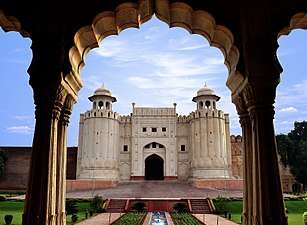 |
Punjab, Pakistan 31°35′25″N 74°18′35″E / 31.59028°N 74.30972°E | 1556 | 171; 1981; i, ii, iii | The Fort and Shalamar Gardens in Lahore are two distinct royal complexes from the Mughal era. The Fort is located at the northwest corner of the Walled City of Lahore and has been destroyed and rebuilt several times during its history. The Shalamar Gardens are example of Mughal Gardens which were constructed by the emperor Shah Jahan in 1642. The gardens are influenced by Persian and Islamic traditions and cover 16 hectares of land area. | [29] |
| Historical Monuments at Makli, Thatta | Sindh, Pakistan 24°46′0″N 67°54′0″E / 24.76667°N 67.90000°E | 14th century to 18th century | 143; 1981; iii | Makli is a necropolis in the archaeological city of Thatta dating back to 14th century. The monuments and mausoleums in Makli are built from high quality stone, brick, and glazed tiles representing the civilization of Sindh of the time. Tombs of famous saints and rulers including Jam Nizamuddin II are still preserved and are evidence of Hindu, Mughal, and Islamic architecture. | [30] | |
| Rohtas Fort | 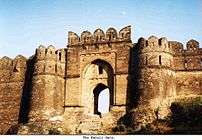 |
Punjab, Pakistan 32°57′45″N 73°35′20″E / 32.96250°N 73.58889°E | 1541 | 586; 1997; ii, iv | Rohtas Fort is a garrison fort built by Sher Shah Suri, located about 16 km from Jhelum in Punjab, Pakistan. The fort is an exceptional example of Islamic military architecture, integrating artistic traditions from Turkey and the Indian subcontinent. It was built at a strategic location on a small hill alongside Kahan River to control the Ghakkars. Its name is derived from Rohtasgarh, the site of Sher Shah's victory in 1539 over a Hindu ruler. | [31] |
Tentative list

In 2004, the Ministry of Tourism pushed forward for new sites in Pakistan to become a UNESCO World Heritage Site. In total, 26 sites are awaiting to be categorised as of 2016 which include:[32][33]
- Badshahi Mosque, Lahore – mosque built in 1673 during Mugal Empire
- Shah Jahan Mosque, Thatta – mosque built in 1647 by Shah Jahan
- Wazir Khan Mosque, Lahore – mosque built in 1635 by Shah Jahan
- Tomb of Jahangir, Tomb of Asif Khan and Akbari Sarai Gateway in Lahore – mausoleum built in 1637
- Tomb of Bibi Jawindi, Baha'al-Halim and Ustead, Mosque of Jalaluddin Bukhari, Uch Sharif – five monuments of historical figures
- Tomb of Shah Rukn-e-Alam, Multan – tomb for sufi Shah Rukn-e-Alam
- Chaukhandi Tombs, Karachi – tombs built during Mughal Empire
- Central Karakoram National Park - largest protected area in northern Pakistan
- Deosai National Park - a high-altitude alpine plain and a national park in Gilgit-Baltistan
- Hingol National Park - a national park in Balochistan
- Hiran Minar and Tank, Sheikhupura – built by Mughal Emperor, Jahangir in 1606
- Mehrgarh, Balochistan – one of the oldest Neolithic ruins and archaeological sites
- Rehman Dheri, Dera Ismail Khan – historical ruins of Indus Valley Civilization
- Harappa, Punjab – historical ruins of the Bronze Age
- Katas Raj Temples - temples near Chakwal which are attributed to Hindu Shahis Eras dating from about 615-950 CE
- Nagarparkar Cultural Landscape - an important center of Jain religion and culture in Sindh
- Mansehra Rock Edicts, Mansehra – earliest writings of the 3rd century BC
- Ranigat, Khyber Pakhtunkhwa – archaeological remains of a Buddhist monastic complex
- Shahbazgarhi Rock Edicts, Mardan – inscriptions of the Mauryan emperor, Ashoka
- Baltit Fort, Hunza Valley – Tibetan-style fort built in the 13th century
- Derawar Fort and the forts of Cholistan Desert - located in Punjab
- Ranikot Fort, Dadu – one of the largest forts in the world
- Port of Banbhore – archaeological site of historical port city on the Indus River
- The Salt Range and Khewra Salt Mine - the second largest and oldest salt mine in the world
- Karez System - in Balochistan
- Ziarat Juniper Forest - a juniper forest in Ziarat, Balochistan
Other landmarks
There are landmarks and structures that have not yet made the UNESCO Tentative List. Long before the creation of Pakistan in 1947, there were cultures and religions that existed before the independence. Pakistan being the centre of various wars led to several dynasties and tribes ruling its lands. They left landmarks behind which some have become national icons whilst others needing the attention of concerned authorities. Some of these include:
- Altit Fort in Hunza Valley
- Bala Hissar Fort in Peshawar
- Chaqchan Mosque in Khaplu
- Frere Hall in Karachi
- Khaplu Palace in Khaplu
- Mahabat Khan Mosque-A Mughal Era mosque in Peshawar
- Faisalabad Clock Tower and the Eight Bazaars
- 17th and 18th-century Tombs of Talpur Mirs
- Faiz Mahal of the Talpur Mirs
- Samadhi of Ranjit Singh
- Mughal built tomb of Asaf Khan at Shahdara Bagh
- Empress Market built during the rule of the British Empire
- The tomb of Qutb-ud-din Aibak, the first Sultan of Delhi and founder of the slave dynasty
- Mohatta Palace, built in 1927
- 18th-century Omar Hayat Mahal
- 19th-century Italian chateau Noor Palace
- The 3000BC built fort of Kot Diji and Faiz Mahal in Khairpur
- 16th-century built fort at Skardu
- Nagar Fort at Chitral
Post-independence Pakistan retained its heritage by constructing sites to commemorate its independence by blending styles and influences from the past. Some of these include:
- Minar-e-Pakistan in Lahore
- Grand Jamia Mosque, Lahore
- Faisal Mosque in Islamabad
- The mausoleum of the founder of Pakistan, Mohammad Ali Jinnah
- Bab-e-Pakistan a memorial site for the victims of the independence
- Pakistan Monument in Islamabad
- The mausoleum of Allama Muhammad Iqbal
Infrastructure and the economy
Tourism is a growing industry in Pakistan. With more and more foreign investment and funding, Pakistan was able to build its major road and air networks to cater mass movements of cargo and inter-city travel. Roads are being developed by several consultants from the Northern Areas all the way down to the Port of Karachi.
Statistics from the last decade show tourism is a "market led industry and not supply driven" which has led a large decline in travel to Pakistan. This has led to fewer tour agencies being set up and development of historical sites. It has been estimated that the public and private sectors have gradually earned less income from the tourism market causing less investment and innovation within the industry. This has led to several sites to depreciate over time and the lack of minimum international standards have left many sites in poor states. The latest budget showed that less money was being spent on research and marketing and more on defence and other fixed markets.
The 2017 World Economic forum's Travel and Tourism Competitiveness Report (TTCR) ranked Pakistan 125th out of 136 countries.[13] Low branding and marketing effectiveness and low priority the government gave to the travel and tourism industry.
Pakistan Tourism Development Corporation
Some have encouraged the government to again attract tourists to Pakistan by initiating the sponsorship of new businesses in the tourist market: building and maintaining the road and air networks to meet international standards. The maturation of human and natural resources can also contribute in development of this feeble industry. Advertising campaigns need to attract tourist by developing holiday packages tailored to explore the greater regions of the country.
In September 2004 with the bifurcation of the Minorities, Culture, Sports,[34] Tourism and Youth Affairs, tourism was given a separate status of Ministry of Tourism. The Ministry of Tourism was responsible for the policy formulation, development, marketing and promotion of foreign and domestic tourism besides coordination and regulating of federal and provincial governments and private sector activities responsible and involved in tourism.[35]

However, it was not able to achieve any of its objectives and was abolished under Constitutional requirements in Pakistan on June 30, 2011. The promotions of tourism was transferred to the provinces. Now each province runs its own organization that is responsible for tourism. It is now part of Pakistan Tourism Development Corporation or PTDC. It is now responsible for the development of tourism sector.
- Tourism Development Corporation of Punjab (TDCP) is working in Punjab for the promotion of the tourism sector.[36]
- Culture Tourism And Antiquities Department - Sindh[37]
- Department of Tourism - Khyber Pakhtunkhwa[38]
- Secretary of Culture, Tourism & Archive - Baluchistan[39]
- Tourism, Sports, Culture and Youth Department - Gilgit-Baltistan[40]
- Department of Tourism - Azad Jammu and Kashmir[41]
Tourism by province and territory
Pakistan is subdivided into four provinces (Balochistan, Khyber Pakhtunkhwa, Punjab and Sindh), two federal territories (Islamabad Capital Territory, Federally Administered Tribal Areas) and two autonomous regions (Azad Jammu and Kashmir and Gilgit-Baltistan).[42]
Gilgit Baltistan
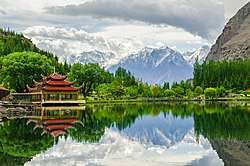 Shangrila Lake and adjoing resort
Shangrila Lake and adjoing resort Cold Desert, Skardu is the world's highest desert.
Cold Desert, Skardu is the world's highest desert. Ambulance on Attabad Lake Hunza
Ambulance on Attabad Lake Hunza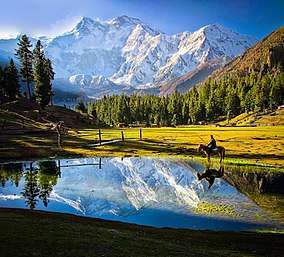
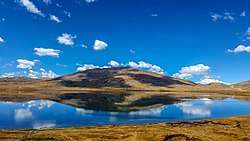 Sheosar Lake is in the western part of Deosai National Park.
Sheosar Lake is in the western part of Deosai National Park.
Gilgit Baltistan is the capital of tourism in Pakistan. Gilgit Baltistan is home to some of the highest peaks in the world, including K2 the second highest peak in the world. Gilgit Baltistan is rich in landscape, mountains, lakes, glaciers and valleys. Gilgit Baltistan is not only famous for its mountains — it is as beautiful as their landmarks, culture, history and people.[43] K2 Basecamp, Deosai, Naltar, Fairy Meadows and Hushe valley are the most beautiful places to visit in Gilgit Baltistan.[44]
Balochistan

- Tourists camped over Quetta


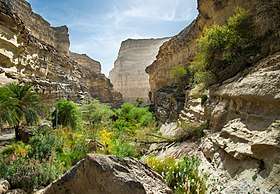
 Moola Chotok a hidden ravine in Khuzdar
Moola Chotok a hidden ravine in Khuzdar
Balochistan is the largest province by geographical area of Pakistan, constituting approximately 43% of the total area. Balochistan is home to one of the oldest Neolithic (7000 BC to c. 2500 BC) sites in archaeology. Mehrgarh and Nausharo was an ancient city linked to the Indus Valley Civilization. Ancient sites dating back 800 years are the Nausherwani tombs at Qila Ladgasht. There was also an ancient port at the site of Oraea which proved to be a useful port during the Hellenistic civilisation.[45]
Quetta is the provincial capital of Balochistan. There are a number of sites of interest including the protected Hazarganji-Chiltan National Park, Hanna Lake, Quetta Geological Museum, Balochistan Arts Council Library, Quetta Archaeological Museum as well as Command and Staff College Museum. The Quaid-e-Azam Residency is another major site in Balochistan in the city of Ziarat. Ziarat is famous for the juniper forests which are the oldest and largest in the world. Sibi, is an important historical city in Balochistan. The Jigra Hall has a collection of pieces found at the archaeological sites of Mehrgarh, Nasshero and Pirak. The annual Sibi Festival marks the famous Horse and Cattle Show.[46]
There are a number of mountain passes within Balochistan. The Bolan Pass has been the main entrance to the provincial city of Quetta. There are several others including Lak Pass, Khojak Pass and Harnai Pass. The Balochistan coastline extends from the Sindh province to the Iranian border measuring a total distance of over 750 km. The city of Gwadar holds the largest port in the province which is based near the ancient area of Makran. Pasni is another beautiful medium-sized town famous for fishing. Along the Makran Coastal Highway there are several rock formations as well as Kund Malir and the Hingol National Park.
Khyber Pakhtunkhwa
.jpg)
 Payee meadows in Shogran, Kaghan Valley
Payee meadows in Shogran, Kaghan Valley Tourists playing cricket in Chitral
Tourists playing cricket in Chitral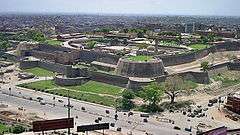

Khyber Pakhtunkhwa is located in the north-west region of Pakistan. It is known as the tourist hotspot for adventurers and explorers. The province has a varied landscape ranging from rugged mountains, valleys, hills and dense agricultural farms. The region is well known for its ancestral roots. There are a number of Buddhist archaeological sites from the Gandhara civilisation such as Takht Bhai and Pushkalavati. There are a number of other Buddhist and Hindu archaeological sites including Bala Hisar Fort, Butkara Stupa, Kanishka stupa, Chakdara, Panjkora Valley and Sehri Bahlol.
Peshawar is the provincial capital of Khyber Pakhtunkhwa. The city is home to a number of sites including Bala Hisar Fort, Peshawar Museum, archaeological site of Gor Khuttree, Mohabbat Khan Mosque, old city of Sethi Mohallah, Jamrud Fort, the Sphola Stupa and the most famous market of Qissa Khawani. The city of Dera Ismail Khan is known to be the entrance into the province from Punjab and Balochistan. The city is famous for its Hindu ruins at Kafir Kot. The Buddhist ruins at Shahbaz Garhi are also famous in the city of Mardan. Heading North, the divisions Swat valley One of the most important cities in the province is Mansehra. The city is a major stop for tourists setting out to the Northern Areas and Azad Kashmir. The city is connected by the famous Karakoram Highway which ends up in China. Along the route there are several stops including the Kaghan Valley, Balakot, Naran, Shogran, Lake Saiful Mulook and Babusar Top. There are also several other sites within the province which attract a large number of tourist every year including Ayubia, Batkhela, Chakdara, Saidu Sharif, Kalam Valley and Hindu Kush mountain range in Chitral.[47]
There are also several mountain passes that run through the province. One of the most famous is the Khyber Pass which links Afghanistan with Pakistan. The trade route sees a large number of trucks and lorries importing and exporting goods in and out of the region. The Babusar Pass is another mountain pass connecting the Thak Nala with Chilas on the Karakorum Highway. The Lowari Pass is another pass which connects Chitral with Dir via the Lowari Tunnel. The highest mountain pass in Pakistan is Shandur Pass which connects Chitral to Gilgit and is known as the Roof of the World. The pass is the centre of three mountain ranges – Hindukush, Pamir and Karakoram.
Punjab


- One of the several food streets in Lahore
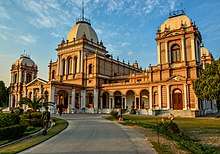 Noor Mahal is a beautiful palace in Bahawalpur.
Noor Mahal is a beautiful palace in Bahawalpur.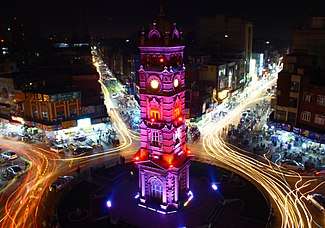 Clock Tower in Faisalabad
Clock Tower in Faisalabad Tomb of Sir James Lyall in Company Bagh, Faisalabad
Tomb of Sir James Lyall in Company Bagh, Faisalabad
Punjab is the second largest province in Pakistan. It is known for its ancient cultural heritage as well as its religious diversity. The lands of Punjab have been home to a number of religions and civilisations. The Indus Valley Civilization once ruled the region and a significant archaeological find was discovered at the ancient city of Harrapa. The Gandhara civilisation was also quite dominant in the northern region of Punjab at the site of Taxila. Several other civilisations such as Greeks, Central Asians, and Persians ruled Punjab leaving a number of sites which still exist today. The arrival of Islam came about during the rule of the Umayyad Caliphate followed by the Ghaznavids. The Mughals took control of the region and ruled its land for several centuries. The mughal heritage remained quite strong in Punjab with a large number of forts, tombs and monuments still intact today. The Durrani Empire ruled the Punjab at the fall of the Mughal Empire for a short period following the rise of the Sikh Empire. The strong control of the Sikhs also lead to a number of sites still remaining intact throughout Punjab. The British Raj took control of the region until the independence.
Tourism in Punjab is regulated by the Tourism Development Corporation of Punjab.[48] There are a number of large cosmopolitan cities in Punjab. The provincial capital, Lahore is the second largest city of Pakistan as is known to the Cultural Heart of Pakistan. The Mughal Empire left behind the Lahore Fort and Shalimar Gardens which are now recognised World Heritage Sites. The Walled City of Lahore, Badshahi Mosque, Wazir Khan Mosque, Tomb of Jahangir and Nur Jahan, Tomb of Asaf Khan and Chauburji are other major sites visited by tourists each year. The tomb of Qutb-ud-din Aibak from the Delhi Sultanate is located in the historical market of Anarkali Bazaar in Lahore. The Samadhi of Ranjit Singh and Hazuri Bagh Baradari are prime example of Sikh architecture during the rule of the Sikh Empire. There a number of other sites within Lahore such as Minar-e-Pakistan, Lahore Museum, Data Durbar Complex, Tomb of Muhammad Iqbal, Bagh-e-Jinnah, Lahore Zoo, Tomb of Shah Jamal, Sukh Chayn Gardens, Gaddafi Stadium which all create a large number of visitors annually.
Rawalpindi is known to be a famous hill station stop for tourists before setting out to Murree, Bhurban, Patriata, Northern Areas, Azad Kashmir and Gilgit-Baltistan.[49] The Pharwala Fort is a major fort on the outskirts of the city built by an ancient Hindu civilisation. There are a number of sites from the Mughal Empire in the city of Sheikhupura called Hiran Minar and the Sheikhupura Fort. The Rohtas Fort near Jhelum is a major fort built by Sher Shah Suri is a World Heritage Site. The Katasraj temple in the city of Chakwal is a major destination for Hindu devotees. The Khewra Salt Mines is another major tourist attraction as its one of the oldest mines in South Asia. The city of Nankana Sahib is birthplace of the founder of Sikhism. The Gurdwara is visited by a number of pilgrims ever year to mark Guru Nanak Dev birthday. Another famous gurdwara in Punjab is Panja Sahib located in the city of Hasan Abdal. The clock tower and eight bazaars of Faisalabad are famous for its bazaars since they were designed to represent the Union Jack flag.[50]
Travelling southwards, the region starts to become more desertic. Multan is another major tourist destination in Punjab. It is known for its mausoleums of saints and Sufi pirs. The most famous are the Rukn-e-Alam and Baha-ud-din Zakariya. The Multan Museum and Nuagaza tombs are significant attractions in the city. The city of Bahwalpur is a major destination as it is located near the Cholistan Desert and Thar Desert. The Derawar Fort is a large fort built in the Cholistan Desert which is also the site for the annual Cholistan Jeep Rally. The city is also near the ancient site of Uch Sharif which was once a Delhi Sultanate stronghold. The Noor Mahal, Sadiq Ghar Palace, Darbar Mall are large palaces built during the reign of the Nawabs. The Lal Suhanra National Park is a major zoological garden on the outskirts of the city.
Sindh
Sindh is located in the south-eastern region of Pakistan. The province is known for its religious heritage and rapid-urbanisation. The province is home to the ancient Indus Valley Civilisation. Mohenjo-daro near the city of Larkana was one of the largest city-settlements in South Asia and is an official UNESCO World Heritage Site. The Chaukhandi tombs are another example of ancient Sindhi and Balochi heritage located near the town of Landi. Another ancient city, Aror, located near the city of Sukkur is also a famous tourist spot for its ruins. Kahu-Jo-Darro is a famous ancient Buddhist archaeological site near Mirpurkhas were a Buddhist stupa was excavated.
The first arrival of Islam in the South Asia took place in Karachi, Sindh, Pakistan. There has been a number of sites within the province that have led archaeologists to suggest this. Makli Hill is one of the largest necropolises in the world. The site is home to a number of ancient tombs and graves of Islamic dynasties. The Talpur Mirs of Hyderabad also left a number of sites including, Tombs of Talpur Mirs, Faiz Mahal in Khairpur, Qasim fort, Pacco Qillo and the Kot Diji Fort in Kot Diji. Another famous fort built during the Islam invasion was the Ranikot Fort. Like other provinces, Sindh has a number of cultural shrines and mausoleums including Thatta, Shah Abdul Latif Bhittai, Lal Shahbaz Qalander, Shahjahan Mosque, Mazar-e-Quaid, Minar-e-Mir Masum Shah, Bhambore and Garhi Khuda Bakhsh.
Karachi is the provincial capital of the province and largest city of Pakistan. It is home to the founder of the nation, Mohammad Ali Jinnah. His tomb, Mazar-e-Quaid, is the most iconic mausoleum in Pakistan. The city has the largest port in the country, Port of Karachi, followed by the second largest, Port Qasim. Karachi has also been ruled under a number of tribes which meant the city is home to a number of cultural sites including, Mohatta Palace, National Museum of Pakistan, Empress Market, Frere Hall, Jehangir Kothari Parade, Karachi Municipal Corporation Building and the Hindu Gymkhana. There are also several beaches within the city, some of the most famous are Clifton Beach, French Beach, Sandspit Beach and Manora Island.
The province also forms the basin for the Indus river. This has led to a number of lakes being formed in the province. Some of the most notable ones include: Keenjhar Lake, Manchar Lake and the Bakri Waro Lake in Khairpur. The Kirthar National Park is also a protected reserve for several wildlife within the region. The Thar Desert is also located in the province which adjorns it to Punjab and India. The Great Rann of Kutch is a protected wetland site in the province. There are two wildlife sanctuaries in the province: Rann of Kutch Wildlife Sanctuary and the Nara Desert Wildlife Sanctuary. The Sukkur Barrage is another famous icon in the province it was built to alleviate famines caused by lack of rain.
Port Grand Food and Entertainment Complex is a recreational area built in the centre of Karachi, Pakistan along the waterfront of the 19th century Native Jetty Bridge that connects the Karachi Port Trust to Keamari. The complex is expected to attract up to 5,000 visitors a day and is a major hub of shopping, dining, cultural and coastal recreational activities in the city. Port Grand is located on Napier Mole Bridge a site that is very significant to the history of Karachi and has played a crucial role in making it the city it is today. The project stretches along 1,000 ft of Karachi's ancient 19th century Native Jetty Bridge and spreads over an area of 200,000 sq. ft. The one kilometre bridge has been transformed into an entertainment and food enclave housing numerous eateries totalling 40,000 sq. ft of climate-controlled area and space for kiosks of exotic Pakistani and foreign food and a variety of beverages. To get to the Port Grand from anywhere in the city, Port Grand is a straight shot west out of Mai Kolachi, adjacent to the PNSC Building as the road curves into the facility on the right.[51]
Azad Jammu and Kashmir
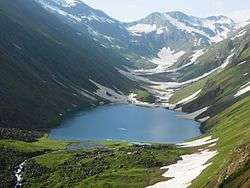
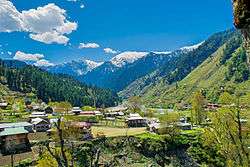 A View of Sharda, Azad Kashmir
A View of Sharda, Azad Kashmir
Azad Kashmir is the region of Pakistan situated in Northern part of the country. The northern part of Azad Jammu and Kashmir encompasses the lower part of the Himalayas, including Jamgarh Peak 4,734 metres (15,531 ft). However, Sarwali peak in the Neelum Valley is the highest peak in the state.Ganga Choti is the peak in Bagh[52] Fertile, green, mountainous valleys are characteristic of Azad Kashmir's geography, making it one of the most beautiful regions on the subcontinent.[53]
The southern parts of Azad Kashmir, including Bhimber, Mirpur and Kotli districts, have extremely hot weather in summers and moderate cold weather in winters. It receives rains mostly in monsoon weather.In the central and northern parts of state weather remains moderate hot in summers and very cold and chilly in winter. Snow fall also occurs there in December and January. This region receives rainfall in both winters and summers. Muzaffarabad and Pattan are among the wettest areas of the state. Throughout most of the region, the average rainfall exceeds 1400 mm, with the highest average rainfall occurring near Muzaffarabad (around 1800 mm). During summer, monsoon floods of the Jhelum and Leepa river are common, due to high rainfall and melting snow.
Islamabad Capital Territory
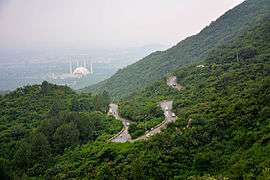 A view of Faisal Mosque, Margalla Hills
A view of Faisal Mosque, Margalla Hills

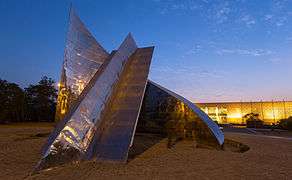 Star and Crescent Monument near the start of Shakarparian
Star and Crescent Monument near the start of Shakarparian
Islamabad is the capital of Pakistan. Islamabad is located in the Pothohar Plateau in the northeastern part of the country, between Rawalpindi District and the Margalla Hills National Park to the north. The region has historically been a part of the crossroads of Punjab and Khyber Pakhtunkhwa with the Margalla Pass acting as the gateway between the two regions. Faisal Mosque (the largest mosque in South Asia), Margalla Hills National Park, Daman-i-Koh, Pakistan Monument, Rawal Lake, Simli Lake and Fatima Jinnah Park are the famous tourists places which are located in Islamabad.[54][55]
List of tourist regions and sites

In October 2006, The Guardian released what it described as "The top five tourist sites in Pakistan" to help the country's tourism industry.[56] Pakistan was ranked 47 out of 200 countries in an analysis of the World Travel and Tourism Council's (WTTC) growth figures by Lovehomeswap.com, which said "If the country becomes more peaceful, visitor numbers are predicted to rise".[57][58]
| Rank | Location |
| 1 | Lahore |
| 2 | Taxila |
| 3 | The Karakoram Highway |
| 4 | Larkana |
| 5 | Lake Saiful Muluk |
Ski resorts and areas
Valleys
Waterfalls
Lakes
- Attabad Lake
- Ansoo Lake
- Banjosa Lake
- Borith Lake
- Chitta Katha Lake
- Daral Lake
- Dudipatsar Lake
- Hana Lake
- Handarap Lake
- Karambar Lake
- Kundol Lake
- Lulusar Lake
- Mahodand Lake
- Pari Lake
- Pyala Lake
- Rama Lake
- Ratti Gali Lake
- Rush Lake
- Saral Lake
- Saiful Muluk
- Shangrila Lake
- Saidgai Lake
- Shounter Lake
- Sheosar Lake
- Satpara Lake
See also
References
- ↑ Malik, Javeria (6 May 2015). "Tourism's Impact on Pakistan Economy : Tourism and its Impact on Pakistan economy".
- ↑ "More than one million tourists visited northern areas of Pakistan this season - The Express Tribune". 5 August 2016.
- ↑ "Improvement in law, order boosts Pakistan's tourism industry". www.pakistantoday.com.pk.
- ↑ Austin Bush. "Pakistan Travel Information and Travel Guide". Lonely Planet. Retrieved 27 September 2010.
- ↑ Correspondent, Sana Jamal, (2017-12-28). "Pakistan tops list of world's best travel destination for 2018". GulfNews. Retrieved 2018-05-23.
- ↑ Ahmed, Amin (9 April 2017). "Pakistan improves ranking on tourism competitiveness index".
- ↑ "TRAVEL & TOURISM ECONOMIC IMPACT 2017 PAKISTAN" (PDF). WORLD TRAVEL & TOURISM COUNCIL. Retrieved 25 April 2018.
- ↑ "Tourism to contribute over Rs1 trillion by 2025 - The Express Tribune". 17 December 2015.
- ↑ Windsor, Antonia (17 October 2006). "Out of the rubble". The Guardian. London. Retrieved 25 May 2010.
- ↑ "Tourism Events in Pakistan in 2010". Tourism.gov.pk. Retrieved 27 September 2010.
- ↑ "The road between China and Pakistan". Financial Times. 4 July 2009. Retrieved 27 September 2010.
- ↑ Paracha, Nadeem (7 July 2008). "Before the Lights Went Out". nadeemfparacha.wordpress.com. Karachi. Archived from the original on 6 March 2010. Retrieved 19 September 2011.
- 1 2 "Country profiles".
- ↑ "International tourism, number of arrivals | Data | Table". data.worldbank.org. Retrieved 2016-06-17.
- 1 2 "Number of foreign tourists in 2014 dips by 50% - The Express Tribune". The Express Tribune. 2014-09-27. Retrieved 2016-06-17.
- ↑ Newspaper, From the (2010-09-10). "2 About 0.9m tourists visited Pakistan in 10 months". www.dawn.com. Retrieved 2016-06-17.
- ↑ "Pakistan - International tourism". www.indexmundi.com. Retrieved 2016-06-17.
- ↑ "Sports Acitivities". John Douglas.
- ↑ PTDC page on mountaineering Archived 2 December 2006 at the Wayback Machine.
- ↑
- ↑ http://data.worldbank.org/indicator/ST.INT.ARVL?locations=PK
- ↑ http://www.brecorder.com/2016/03/16/285426/
- ↑ http://www.radio.gov.pk/27-Feb-2017/promotion-of-tourism-over-seven-hundred-thousand-foreign-tourists-visited-pakistan
- ↑ "Terms of Service Violation". www.bloomberg.com.
- ↑ Dawn.com (30 September 2017). "Foreign tourists to Pakistan more than triple since 2013".
- ↑ "Archaeological Ruins at Moenjodaro". World Heritage Sites. UNESCO. Retrieved 7 September 2012.
- ↑ "Taxila". World Heritage Sites. UNESCO. Retrieved 7 September 2012.
- ↑ "Buddhist Ruins of Takht-i-Bahi and Neighbouring City Remains at Sahr-i-Bahlol". World Heritage Sites. UNESCO. Retrieved 7 September 2012.
- ↑ "Fort and Shalamar Gardens in Lahore". World Heritage Sites. UNESCO. Retrieved 7 September 2012.
- ↑ "Historical Monuments at Makli, Thatta". World Heritage Sites. UNESCO. Retrieved 7 September 2012.
- ↑ "Rohtas Fort". World Heritage Sites. UNESCO. Retrieved 7 September 2012.
- ↑ "Pakistan have 26 sites on tentative list for UNESCO World Heritage Site". Nation.com.pk. Retrieved 2 July 2018.
- ↑ "Sites on the Tentative List". whc.unesco.org. Retrieved 6 August 2018.
- ↑ "Wrestling". John Douglas.
- ↑ "Analysis Tourism Management In Pakistan" (PDF). Retrieved 27 September 2010.
- ↑ "Tourism Development Corporation of Punjab". Archived from the original on 26 June 2015. Retrieved 9 June 2015.
- ↑ "Archived copy". Archived from the original on 9 February 2014. Retrieved 9 February 2014.
- ↑ "Departments". Archived from the original on 15 June 2015. Retrieved 9 June 2015.
- ↑ "Culture, Tourism & Archives - Government of Balochistan". Retrieved 9 June 2015.
- ↑ "Archived copy". Archived from the original on 26 April 2014. Retrieved 26 April 2014.
- ↑ "Under Maintenance". Archived from the original on 28 April 2015. Retrieved 9 June 2015.
- ↑ "Constitution of Pakistan" (PDF). Ministry of Foreign Affairs, Government of Pakistan. Archived from the original (PDF) on 11 August 2006. Retrieved 30 March 2010.
- ↑ Skardu, pk. "Top 10 Most beautiful plces to visit in Pakistan". Skardu.pk. Retrieved 18 February 2017.
- ↑ "5 Most Beautiful Places To Visit in Gilgit Baltistan". Skardu.pk. www.skardu.pk. Retrieved 1 October 2017.
- ↑ "Government of Balochistan: Tourist Attractions". Balochistan.gov.pk. Archived from the original on 17 July 2011. Retrieved 27 September 2010.
- ↑ "Tourist Guide For Baluchistan Pakistan". Rehmananwar.blogspot.com. 1 July 1977. Archived from the original on 8 July 2011. Retrieved 27 September 2010.
- ↑ "Tourism Potential Investment Opportunities in Khyber Pakhtunkhwa". Khyberpakhtunkhwa.gov.pk. Archived from the original on 14 September 2010. Retrieved 27 September 2010.
- ↑ "Tourism Development Corporation of Punjab Official Website". Tdcp.gop.pk. 9 April 2010. Retrieved 27 September 2010.
- ↑ "Ministry of Tourism: Punjab Attractions". Tourism.gov.pk. Retrieved 27 September 2010.
- ↑ khalid. "Tourism in Punjab, Pakistan". Vista-tourism.com. Archived from the original on 15 August 2010. Retrieved 27 September 2010.
- ↑ "Good times: Port Grand finally makes a grand opening - The Express Tribune". 29 May 2011.
- ↑ "Archived copy". Archived from the original on 10 July 2015. Retrieved 14 June 2015.
- ↑ "Azad Kashmir" at britannica.com
- ↑ "Tourism in Islamabad". www.islamabad.net. Retrieved 14 October 2018.
- ↑ "Islamabad Travel - Lonely Planet". www.lonelyplanet.com. Retrieved 14 October 2018.
- ↑ Windsor, Antonia (17 October 2006). "Out of the rubble". The Guardian. London. Retrieved 25 May 2010.
- ↑ "Angola and Gabon 'to become holiday hotspots'". Telegraph.co.uk. Retrieved 9 June 2015.
- ↑ "Top 50 holiday hotspots to watch - Love Home Swap". Love Home Swap. Retrieved 9 June 2015.
Further reading
External links
| Wikivoyage has a travel guide for Pakistan. |
| Wikimedia Commons has media related to Tourism in Pakistan. |
- Ministry of Tourism, Government of Pakistan
- Department of Tourism, Government of Khyber Pakhtunkhwa
- Official site, Government of Balochistan
- Department of Tourism, Government of Punjab
- Department of Culture & Tourism, Government of Sindh
- Department of Tourism, Government of Azad Jammu and Kashmir
- Department of Tourism, Government of Gilgit-Baltistan
